Application of Transient Electromagnetic Method for Investigating the Water-Enriched Mined-Out Area
Abstract
:Featured Application
Abstract
1. Introduction
2. Materials and Methods
2.1. Geologic Setting
2.2. Theory of Large-Loop TEM
2.3. Field Operation
3. Results and Interpretation
4. Conclusions
Author Contributions
Funding
Conflicts of Interest
References
- Wu, C.; Hu, X.; Wang, G.; Xi, Y.; Lin, W.; Liu, S.; Yang, B.; Cai, J. Magnetotelluric Imaging of the Zhangzhou Basin Geothermal Zone, Southeastern China. Energies 2018, 11, 2170. [Google Scholar] [CrossRef]
- Imal, M.; Yilmaz, K.; Pinarbasi, A. Energy Efficiency Evaluation and Economic Feasibility Analysis of a Geothermal Heating and Cooling System with a Vapor-Compression Chiller System. Sustainability 2015, 7, 12926–12946. [Google Scholar] [CrossRef] [Green Version]
- He, L.F.; Chen, L.; Xi, X.L.; Zhao, X.F.; Chen, R.J.; Yao, H.C. Mapping the Geothermal System Using AMT and MT in the Mapamyum (QP) Field, Lake Manasarovar, Southwestern Tibet. Energies 2016, 9, 855. [Google Scholar] [CrossRef]
- Majorowicz, J.; Minea, V. Geothermal Energy Potential in Low Enthalpy Areas as a Future Energy Resource: Identifying Feasible Targets, Quebec, Canada, Study Case. Resources 2015, 4, 524–547. [Google Scholar] [CrossRef] [Green Version]
- Topliceanu, L.; Puiu, G.P. Contribution of Geothermal Resources to Energy Autonomy: Evaluation and Management Methodology. Energies 2016, 9, 612. [Google Scholar] [CrossRef]
- Maryanto, S.; Dewi, C.N.; Syahra, V.; Rachmansyah, A.; Foster, J.H.; Nadhir, A.; Santoso, D.R. Magnetotelluric-Geochemistry Investigations of Blawan Geothermal Field, East Java, Indonesia. Geosciences 2017, 7, 41. [Google Scholar] [CrossRef]
- Yu, X.; Wang, X.B.; Li, X.J.; Lin, X.J.; Yang, F.; Tang, M.E. Three-dimensional finite difference forward modeling of the transient electromagnetic method in the time domain. Chin. J. Geophys. 2017, 60, 810–819. [Google Scholar]
- Xue, G.Q.; Yan, S.; Zhou, N.N. Theoretical study on the errors caused by dipole hypothesis of large-loop TEM response. Chin. J. Geophys. 2011, 54, 2389–2396. [Google Scholar]
- Younger, P.L. Geothermal Energy: Delivering on the Global Potential. Energies 2015, 8, 11737–11754. [Google Scholar] [CrossRef] [Green Version]
- Lewerissa, R.; Sismanto, S.; Setiawan, A.; Pramumijoyo, S. The Study of Geological Structures in Suli and Tulehu Geothermal Regions (Ambon, Indonesia) Based on Gravity Gradient Tensor Data Simulation and Analytic Signal. Geosciences 2018, 8, 4. [Google Scholar] [CrossRef]
- Xu, P.; Zhang, M.X.; Lin, Z.B.; Cao, Z.Z.; Chang, X. Additional Stress on a Buried Pipeline under the Influence of Coal Mining Subsidence. Adv. Civ. Eng. 2018. [Google Scholar] [CrossRef]
- Xue, G.Q.; Cheng, J.L.; Zhou, N.N.; Chen, W.Y.; Li, H. Detection and monitoring of water-filled voids using transient electromagnetic method: A case study in Shanxi, China. Environ. Earth Sci. 2013, 70, 2263–2270. [Google Scholar] [CrossRef]
- Kozhevnikov, N.O.; Antonov, E.Y. Magnetic viscosity effect on TEM data of an array with a fixed transmitter loop. Russ. Geol. Geophys. 2018, 59, 690–696. [Google Scholar] [CrossRef]
- Sanmiquel, L.; Bascompta, M.; Vintro, C.; Yubero, T. Subsidence Management System for Underground Mining. Minerals 2018, 8, 243. [Google Scholar] [CrossRef]
- Krawczyk, A.; Grzybek, R. An evaluation of processing InSAR Sentinel-1A/B data for correlation of mining subsidence with mining induced tremors in the Upper Silesian Coal Basin (Poland). In Proceedings of the Seminary on Geomatics, Civil and Environmental Engineering, Gdansk, Poland, 22–25 June 2017; Nykiel, G., Ed.; EDP Sciences: Les Ulis, France, 2018; Volume 26. [Google Scholar]
- Roser, J.; Potocnik, D.; Vulic, M. Analysis of Dynamic Surface Subsidence at the Underground Coal Mining Site in Velenje, Slovenia through Modified Sigmoidal Function. Minerals 2018, 8, 74. [Google Scholar] [CrossRef]
- Wu, G.J.; Yang, G.L.; Tan, H.B. Mapping coalmine goaf using transient electromagnetic method and high density resistivity method in Ordos City, China. Geod. Geodyn. 2016, 7, 340–347. [Google Scholar] [CrossRef]
- Chen, W.Y.; Xue, G.Q.; Olatayo, A.L.; Chen, K.; Khan, M.Y.; Chen, W.C.; Zhang, L.B.; Chen, W. A comparison of loop time-domain electromagnetic and short-offset transient electromagnetic methods for mapping water-enriched zones—A case history in Shaanxi, China. Geophysics 2017, 82, B201–B208. [Google Scholar] [CrossRef]
- Xue, G.Q.; Mohammed, E.A.E.; Guo, W.B. The Response of Large-loop Transient Electromagnetic. Univ. Afr. J. Sci. 2016, 1, 1–17. [Google Scholar]
- Christensen, N.B. Two-Dimensional Imaging of Transient Electromagnetic Soundings. In Proceedings of the Symposium on the Application of Geophysics to Engineering and Environmental Problems, Reno, NV, USA, 23–26 March 1997; Environment and Engineering Geophysical Society: Denver, CO, USA, 2015; pp. 397–406. [Google Scholar]
- Chongo, M.; Christiansen, A.V.; Fiandaca, G.; Nyambe, I.A.; Larsen, F.; Bauer-Gottwein, P. Mapping localised freshwater anomalies in the brackish paleo-lake sediments of the Machile-Zambezi Basin with transient electromagnetic sounding, geoelectrical imaging and induced polarisation. J. Appl. Geophys. 2015, 123, 81–92. [Google Scholar] [CrossRef] [Green Version]
- Xue, G.Q.; Qin, K.Z.; Li, X.; Li, G.M.; Qi, Z.P.; Zhou, N.N. Discovery of a Large-scale Porphyry Molybdenum Deposit in Tibet through a Modified TEM Exploration Method. J. Environ. Eng. Geophys. 2012, 17, 19–25. [Google Scholar] [CrossRef]
- Simard, P.T.; Chesnaux, R.; Rouleau, A.; Daigneault, R.; Cousineau, P.A.; Roy, D.W.; Lambert, M.; Poirier, B.; Poignant-Molina, L. Imaging Quaternary glacial deposits and basement topography using the transient electromagnetic method for modeling aquifer environments. J. Appl. Geophys. 2015, 119, 36–50. [Google Scholar] [CrossRef]
- Abu Rajab, J.S.; El-Naqa, A.R. Mapping groundwater salinization using transient electromagnetic and direct current resistivity methods in Azraq Basin, Jordan. Geophysics 2013, 78, B89–B101. [Google Scholar] [CrossRef]
- Li, H.; Xue, G.-Q.; Zhou, N.-N.; Chen, W.-Y. Appraisal of an Array TEM Method in Detecting a Mined-Out Area Beneath a Conductive Layer. Pure Appl. Geophys. 2015, 172, 2917–2929. [Google Scholar] [CrossRef]
- Xue, G.; Chen, W.; Zhong, H. Mapping coal-beds water-filled zones by using SOTEM. In Proceedings of the International Workshop and Gravity, Electrical & Magnetic Methods and their Applications, Chenghu, China, 19–22 April 2015; pp. 482–485. [Google Scholar]
- Xue, G.Q.; Bai, C.Y.; Yan, S.; Greenhalgh, S.; Li, M.F.; Zhou, N.N. Deep sounding TEM investigation method based on a modified fixed central-loop system. J. Appl. Geophys. 2012, 76, 23–32. [Google Scholar] [CrossRef]
- Nabighian, M.N. Quasi-static transient response of a conducting half-space—An approximate representation. Geophysics 1979, 44, 1700–1705. [Google Scholar] [CrossRef]
- Yu, C.T.; Liu, H.F.; Zhang, X.J.; Yang, D.Y.; Li, Z.H. The analysis on IP signals in TEM response based on SVD. Appl. Geophys. 2013, 10, 79–87. [Google Scholar] [CrossRef]
- Tiwari, A.K.; Maurya, S.P.; Singh, N.P. TEM Response of a Large Loop Source over the Multilayer Earth Models. Int. J. Geophys. 2018, 9891548. [Google Scholar] [CrossRef]
- Nabighian, M.N.; Macnae, J.C. Time Domain Electromagnetic Prospecting Methods. Electromagn. Methods Appl. Geophys. 1991, 427–520. [Google Scholar] [CrossRef]
- Goldman, M.M. The Integral-Finite-Difference Method for Calculating Transient Electromagnetic-Fields in a Horizontally Stratified Medium. Geophys. Prospect. 1983, 31, 664–686. [Google Scholar] [CrossRef]
- Xue, G.Q.; Chen, W.Y.; Ma, Z.J.; Hou, D.Y. Identifying Deep Saturated Coal Bed Zones in China through the Use of Large Loop TEM. J. Environ. Eng. Geophys. 2018, 23, 135–142. [Google Scholar]
- Haroon, A.; Adrian, J.; Bergers, R.; Gurk, M.; Tezkan, B.; Mammadov, A.L.; Novruzov, A.G. Joint inversion of long-offset and central-loop transient electromagnetic data: Application to a mud volcano exploration in Perekishkul, Azerbaijan. Geophys. Prospect. 2015, 63, 478–494. [Google Scholar] [CrossRef]
- Hoheisel, A.; Hordt, A.; Hanstein, T. The influence of induced polarization on long-offset transient electromagnetic data. Geophys. Prospect. 2004, 52, 417–426. [Google Scholar] [CrossRef]

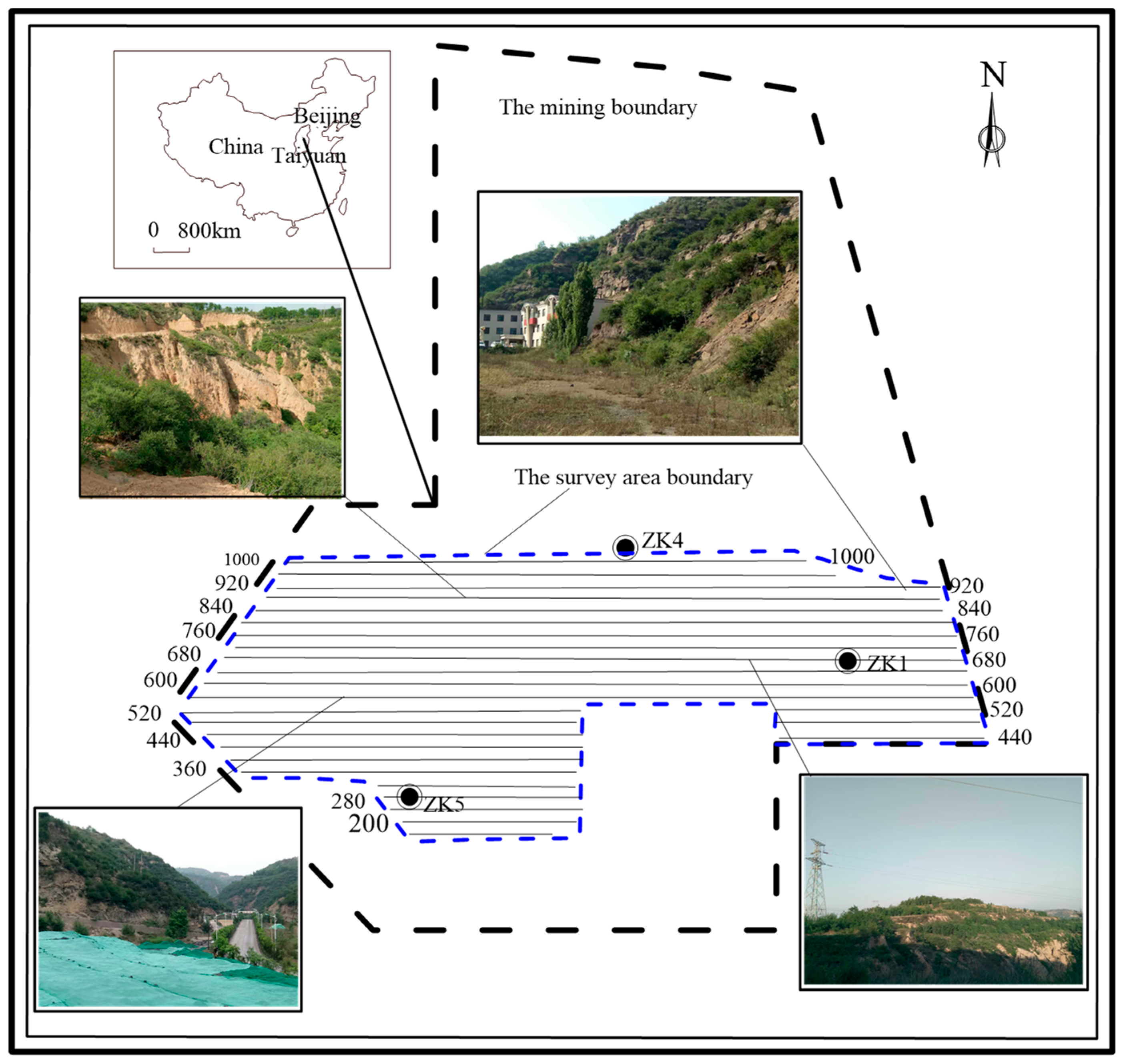
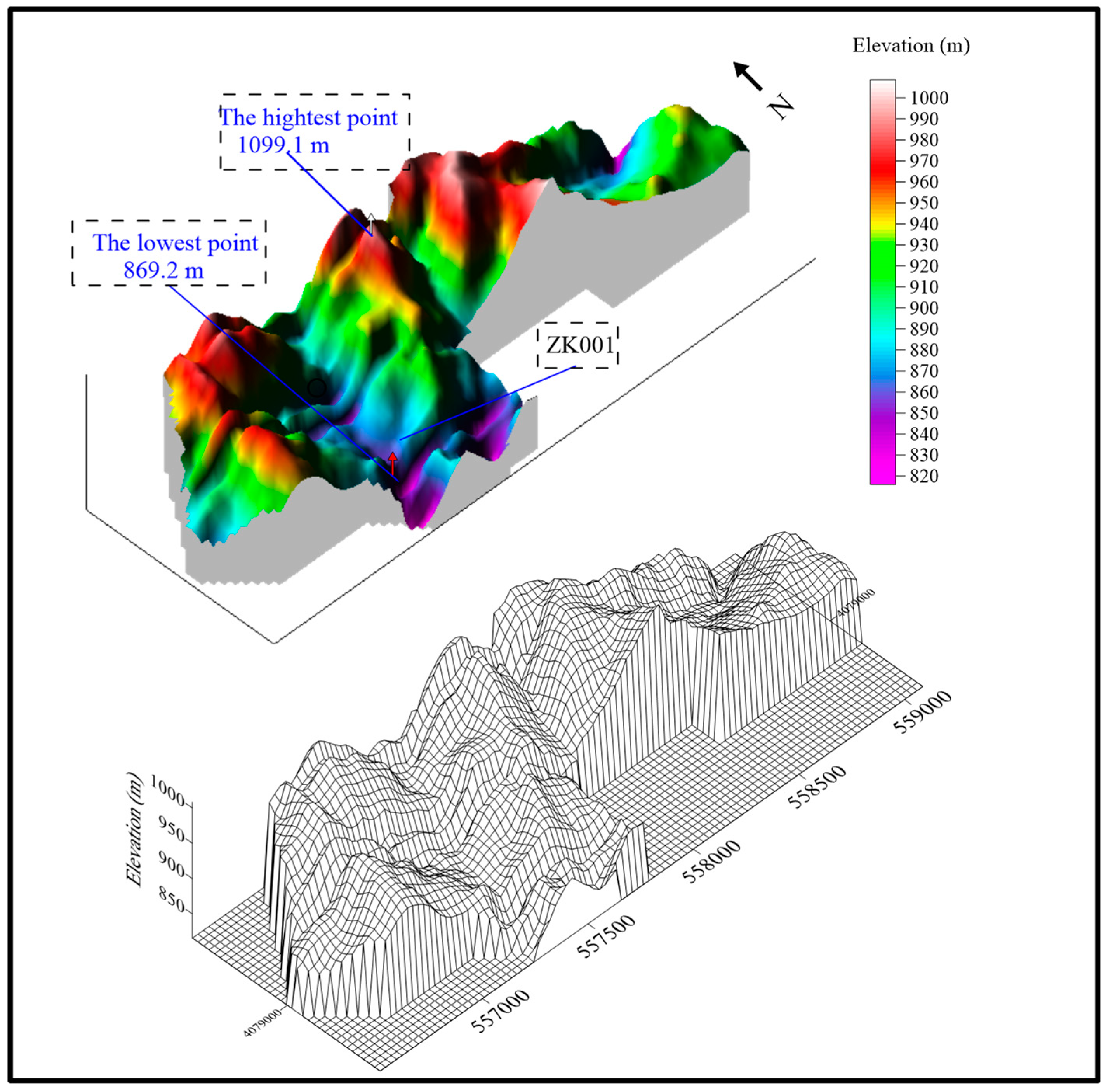
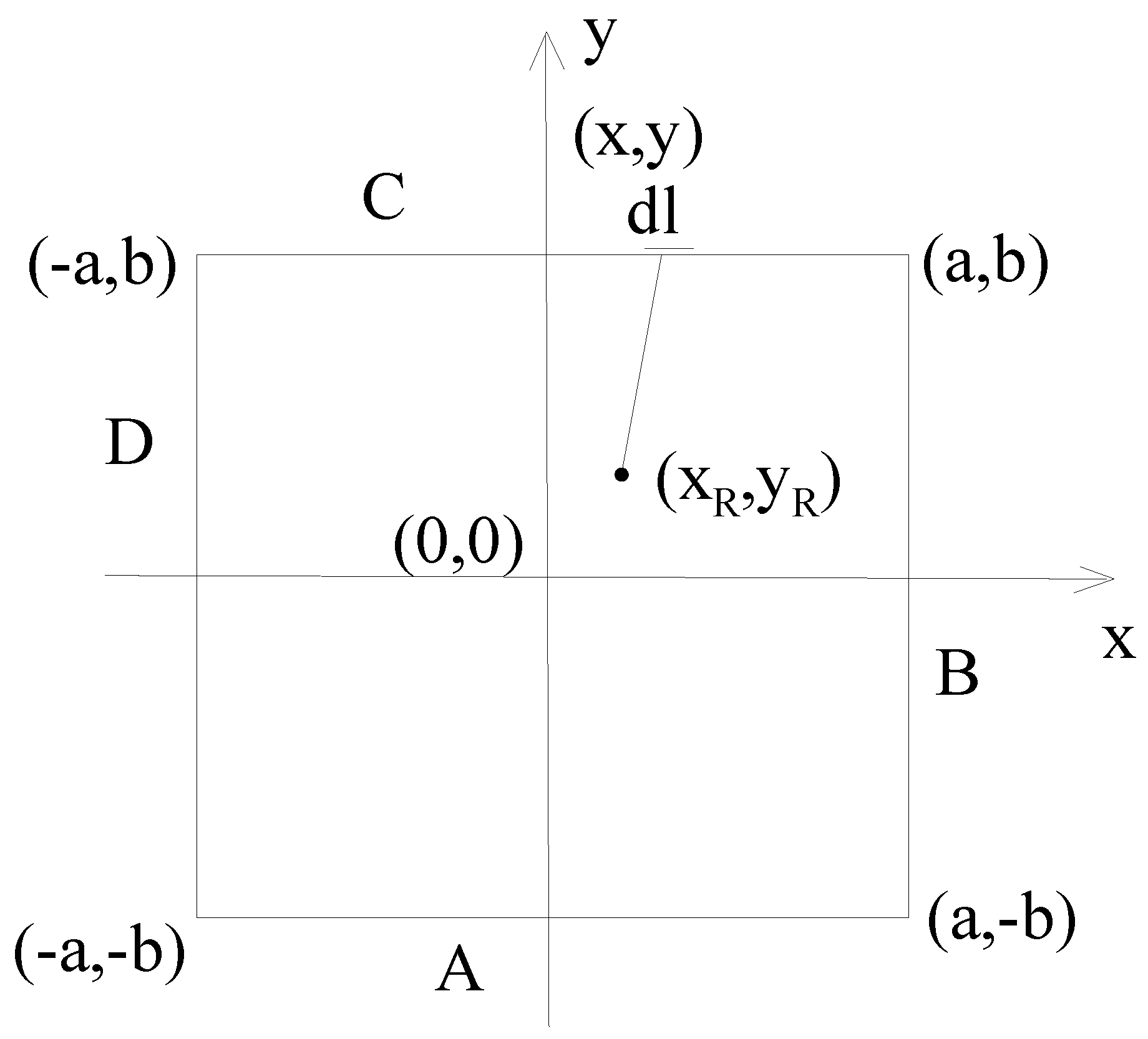

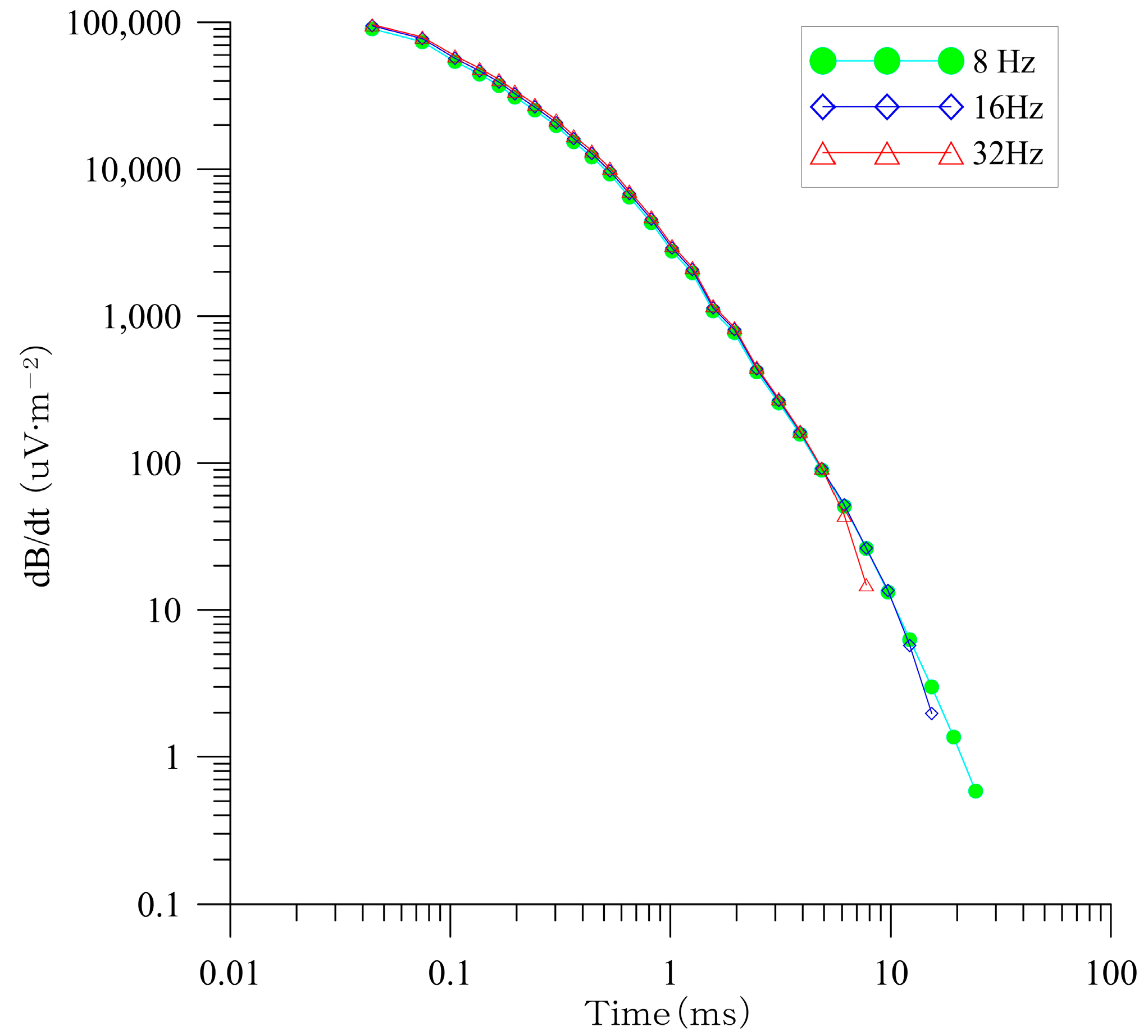
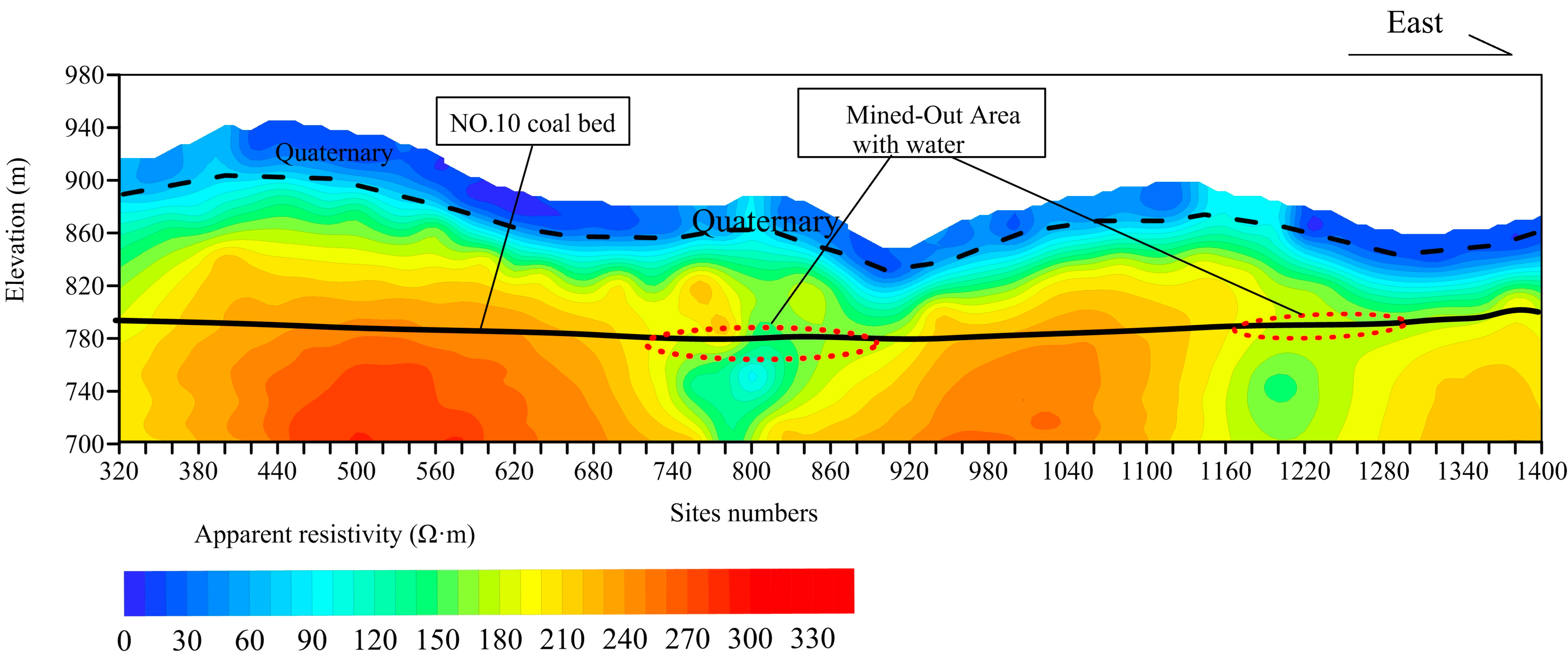
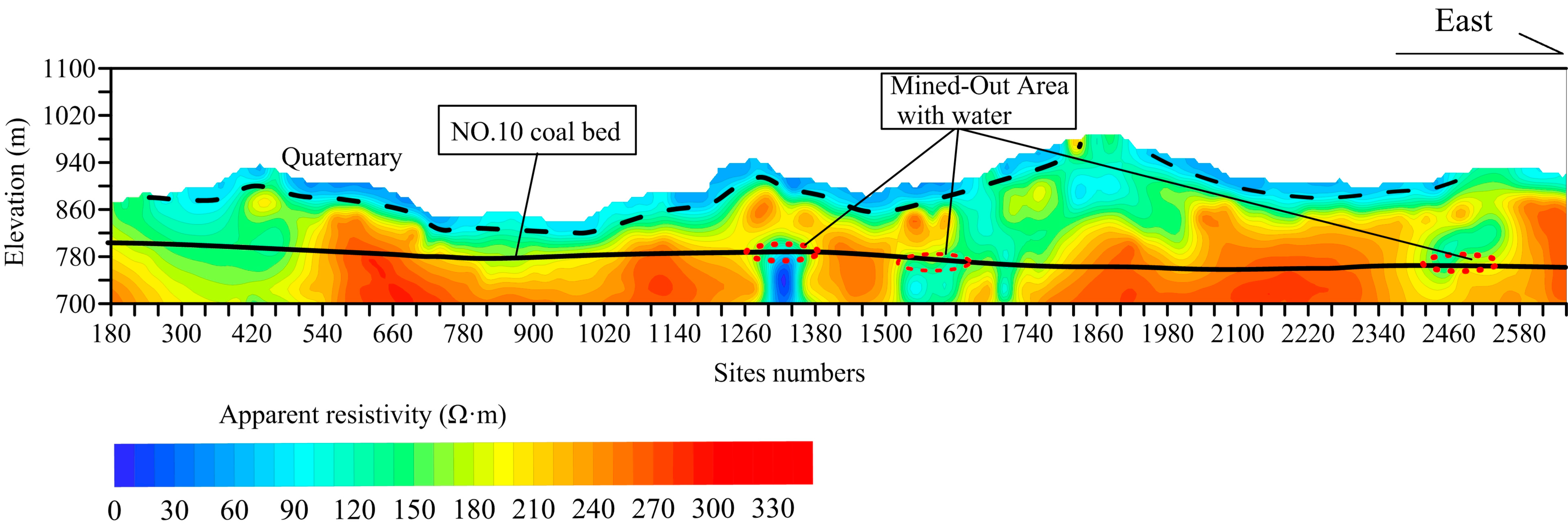

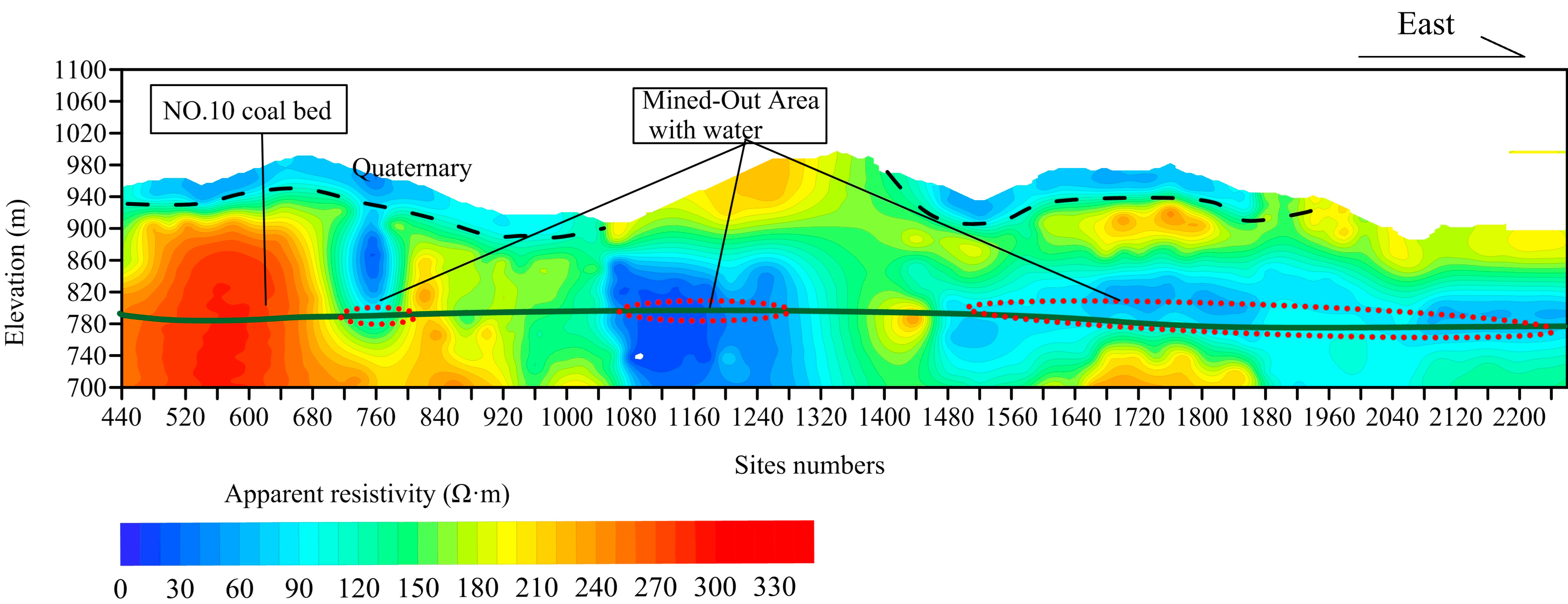

| Stratum | Lithology | Resistivity/Ω·m | |
|---|---|---|---|
| Quaternary (Q) | Loess, alluvium | 40–80 | |
| Triassic (T) | Ermaying formation (T2er) Heshanggou formation (T2h) Liujiagou formation (T1l) | Mudstone Sandstone | 50–200 |
| Permian (P) | Shiqianfeng formation (P2sh) | Sandstone, sandy mudstone, and coal | 150–300 |
| Upper Shihezi formation (P2s) | |||
| Lower Shihezi formation (P1x) | |||
| Shanxi formation (P1s) | |||
| Carboniferous (C) | Taiyuan formation (C3t) Benxi formation (C2b) | Sandstone, siltstone, mudstone, bauxite limestone, and coal | 220–420 |
| Ordovician (O) | Fengfeng formation(O2f) | Limestone | 700 |
© 2018 by the authors. Licensee MDPI, Basel, Switzerland. This article is an open access article distributed under the terms and conditions of the Creative Commons Attribution (CC BY) license (http://creativecommons.org/licenses/by/4.0/).
Share and Cite
Yu, C.; Liu, X.; Liu, J.; Li, E.; Yue, P.; Yan, S. Application of Transient Electromagnetic Method for Investigating the Water-Enriched Mined-Out Area. Appl. Sci. 2018, 8, 1800. https://doi.org/10.3390/app8101800
Yu C, Liu X, Liu J, Li E, Yue P, Yan S. Application of Transient Electromagnetic Method for Investigating the Water-Enriched Mined-Out Area. Applied Sciences. 2018; 8(10):1800. https://doi.org/10.3390/app8101800
Chicago/Turabian StyleYu, Chuantao, Xinyue Liu, Jishan Liu, Enguo Li, Peng Yue, and Shuaibin Yan. 2018. "Application of Transient Electromagnetic Method for Investigating the Water-Enriched Mined-Out Area" Applied Sciences 8, no. 10: 1800. https://doi.org/10.3390/app8101800





